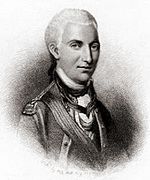Richard Parker (colonel)
[3] The commander of this unit, William Woodford led his troops at the Battle of Great Bridge on 9 December 1775[4] and at Norfolk on 1 January 1776.
[6] This regiment was transferred to Adam Stephen's brigade in George Washington's main army on 3 September 1776.
[8] Major Parker is listed as acting commander of the 6th Virginia at the time of the battles of Assunpink Creek and Princeton on 2 and 3 January 1777.
[11] At the Battle of Brandywine on 11 September 1777, William Maxwell led a force of light infantry to delay the British advance toward Chadds Ford.
Beginning at 6:00 AM, the light infantry fought a delaying action against Patrick Ferguson's riflemen and the Queen's Rangers.
Scott's command also included three detachments under Richard Butler, Joseph Cilley, and Mordecai Gist.
The detachments of Parker and Cilley stayed behind to screen the left front of Washington's main body which was by then on the field.
[25] While the two-hour barrage continued, the British made an attempt to turn the American left flank.
With the help of a 6-pound cannon that brought enfilading fire to bear, the American attack pushed the Highlanders back 300 yards (270 m).
[29] On 7 May 1779, Washington sent Parker to Virginia to recruit troops to reinforce Benjamin Lincoln's southern army.
They arrived at Charleston, South Carolina on 5 December and were joined by the second echelon under William Heth on 7 April.
[1] He was one of about 90 Americans killed during the siege, which resulted in Lincoln's surrender of 2,650 Continental Army soldiers, plus militia.


